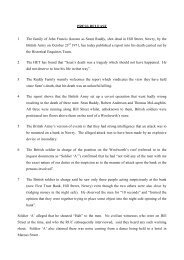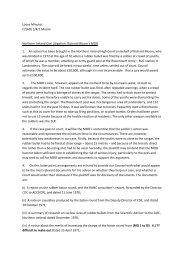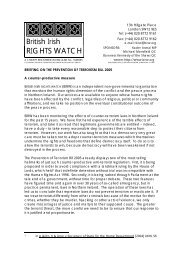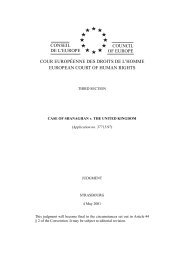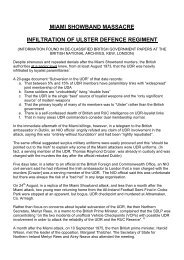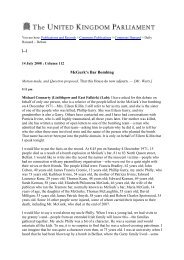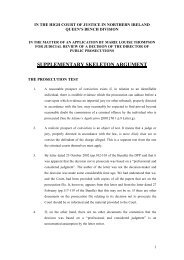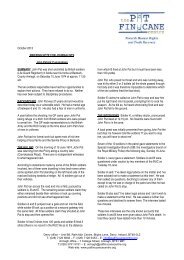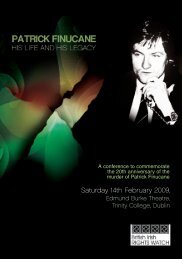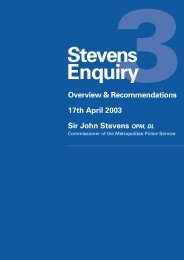HET Review Summary Report into the death of William Francis ...
HET Review Summary Report into the death of William Francis ...
HET Review Summary Report into the death of William Francis ...
Create successful ePaper yourself
Turn your PDF publications into a flip-book with our unique Google optimized e-Paper software.
Doctor H.M.BENNETT<br />
Detective Sergeant Ruddell <strong>of</strong> <strong>the</strong> RUC interviewed Doctor Bennett on<br />
September 15, 1971.<br />
He said that at 1.25am on September 15, 1971 he attended at <strong>the</strong> Out-<br />
Patients Theatre within <strong>the</strong> Accident and Emergency Department <strong>of</strong><br />
Altnagelvin hospital, Londonderry, where he saw Mr McGreanery who had<br />
been admitted with serious gunshot wounds. He commenced operating on<br />
<strong>the</strong> patient who had a wound to <strong>the</strong> left chest and was bleeding severely<br />
from <strong>the</strong> left lung. He said that Mr McGreanery died from his wounds at<br />
3.12am that same morning.<br />
Post Mortem Examination<br />
At 3.05pm on Wednesday, September 15, 1971 <strong>the</strong> Deputy State<br />
Pathologist for Nor<strong>the</strong>rn Ireland, Doctor Derek Carson, carried out a<br />
post mortem examination on Mr McGreanery at <strong>the</strong> Altnagelvin hospital<br />
Mortuary. Dr Carson said <strong>the</strong> wound to <strong>the</strong> left forearm was 4” below <strong>the</strong><br />
elbow and had been caused by <strong>the</strong> passage <strong>of</strong> a bullet through <strong>the</strong> fleshy<br />
tissue. Dr Carson was <strong>of</strong> <strong>the</strong> opinion that <strong>the</strong> bullet had passed through<br />
<strong>the</strong> forearm before hitting Mr McGreanery’s chest and exiting through<br />
his back.<br />
Doctor Carson described <strong>the</strong> chest wounds as follows: -<br />
“One appeared to have been located on <strong>the</strong> front <strong>of</strong> <strong>the</strong> chest in <strong>the</strong><br />
region <strong>of</strong> <strong>the</strong> left breast and this was described as an entrance wound.<br />
The o<strong>the</strong>r, called an exit wound was located on <strong>the</strong> left side <strong>of</strong> <strong>the</strong> back<br />
<strong>of</strong> <strong>the</strong> chest. There were corresponding holes in <strong>the</strong> chest wall, <strong>the</strong> line<br />
connecting <strong>the</strong>m passing from front to back, from left to right at an<br />
angle <strong>of</strong> about 20 degrees to <strong>the</strong> sagittal plane and slightly downwards at<br />
an angle <strong>of</strong> about 10 degrees to <strong>the</strong> horizontal plane.<br />
There were two fur<strong>the</strong>r wounds on <strong>the</strong> inner side <strong>of</strong> <strong>the</strong> left forearm, 4<br />
inches below <strong>the</strong> elbow. These were caused by <strong>the</strong> passage <strong>of</strong> a bullet<br />
through <strong>the</strong> fleshy tissues <strong>of</strong> <strong>the</strong> forearm and are likely to have been<br />
caused by <strong>the</strong> same bullet which passed through <strong>the</strong> chest. Their size and<br />
appearance would lend support to <strong>the</strong> view that <strong>the</strong> bullet first passed<br />
through <strong>the</strong> forearm before entering <strong>the</strong> front <strong>of</strong> <strong>the</strong> left chest and<br />
leaving at <strong>the</strong> back. At <strong>the</strong> time <strong>the</strong> forearm must have been flexed at<br />
27/5/2010<br />
22



